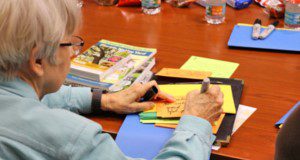Extension professionals and other practitioners address a wide variety of complex issues by providing education and encouraging behavior change using innovative strategies. The importance of prioritizing potential behaviors and selecting those with high expected impact cannot be overemphasized. However, behavior selection can be complicated because there are many solutions for any problem in a particular context. Using an approach drawn from social marketing to develop activities aimed at changing or maintaining people’s behavior, Extension professionals and other practitioners can prioritize behaviors by mathematically calculating anticipated weights that will help focus efforts around key behaviors with the potential to make the greatest impact. This new 6-page publication of the UF/IFAS Department of Agricultural Education and Communication provides an overview of a process to collect and analyze the impact and the likelihood of adoption to help Extension professionals decide on behaviors for a campaign or intervention. Written by Laura A. Warner and John M. Diaz.
https://edis.ifas.ufl.edu/wc375
Tag: Behavior change
Making Action Easier: Behavioral Economics and Nudges for Extension Professionals
As Extension turns more to effecting behavior change beyond simply raising awareness or understanding concerns, how do we not only help clientele make a change, but make it easier? Behavioral economics principles can improve the way we present options to clients, increasing the likelihood of them choosing desirable behaviors. This new 3-page publication of the UF/IFAS Department of Agricultural Education and Communication offers an introduction to these concepts as well as practical strategies for setting up the environment for change. Written by Laura Warner, Kathryn Stofer, and Hayk Khachatryan.
https://edis.ifas.ufl.edu/wc343
Using Journey Mapping within Extension: A Tool for Supporting Behavior-Change Programs
 Extension is an important change agency, and Extension professionals use innovative strategies to help target audiences to adopt research-based practices and technologies. Tools from commercial marketing can be applied to behavior-change campaigns, often through an underused approach known as social marketing. Journey maps can be developed with Extension clients to provide insight into their progression and decision-making from one place or state of being to another. A journey can be the steps a person takes when selecting plants for the landscape, the decision-making process used when identifying agricultural business strategies, or the steps a person takes when leaving a workshop and travelling to their home. This new 9-page publication of the UF/IFAS Department of Agricultural Education and Communication, written by Colby Silvert and Laura A. Sanagorski Warner, presents possible applications of journey mapping within an Extension context.
Extension is an important change agency, and Extension professionals use innovative strategies to help target audiences to adopt research-based practices and technologies. Tools from commercial marketing can be applied to behavior-change campaigns, often through an underused approach known as social marketing. Journey maps can be developed with Extension clients to provide insight into their progression and decision-making from one place or state of being to another. A journey can be the steps a person takes when selecting plants for the landscape, the decision-making process used when identifying agricultural business strategies, or the steps a person takes when leaving a workshop and travelling to their home. This new 9-page publication of the UF/IFAS Department of Agricultural Education and Communication, written by Colby Silvert and Laura A. Sanagorski Warner, presents possible applications of journey mapping within an Extension context.
http://edis.ifas.ufl.edu/wc333
![[Impact × Current adoption levels × Likelihood] = Weight; A social marketing approach to prioritizing potential behaviors for an intervention.](https://edis-news.ifas.ufl.edu/wp-content/uploads/2020/10/wc375-300x160.jpg)
